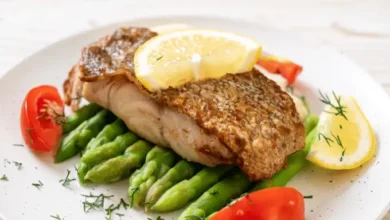CREAMY RED PEPPER SAUCE

Welcome to the flavorful world of creamy red pepper sauce! We’ll explore an easy-to-follow recipe combining roasted red peppers’ rich sweetness and creamy textures to create a delectable sauce perfect for your favorite pasta dishes. Whether you’re a seasoned chef or a cooking novice, this recipe will guide you through each step, from selecting the right ingredients to mastering the blending process. Get ready to elevate your culinary skills and delight your taste buds with this irresistible sauce. Let’s dive in!
Understanding Ingredients and Substitutions
Create the perfect creamy red pepper sauce; it’s essential to understand the key ingredients and potential substitutions that can enhance or alter the flavor profile of your dish. Let’s delve into the components of this recipe:
Red Peppers
- The star ingredient of this sauce, red peppers, brings a sweet and slightly smoky flavor when roasted. For convenience, you can use fresh red bell peppers or jarred roasted red peppers.
- Substitution: While red peppers are traditional, you can experiment with other varieties, such as yellow or orange peppers, for a slightly different flavor profile.
Aromatics
- Garlic and onion add depth and complexity to the sauce. It is typically sautéed before adding the roasted peppers to develop their flavors.
- Substitution: If you prefer a milder flavor, you can reduce the amount of Garlic or omit it altogether. Likewise, you can use shallots instead of onions for a slightly sweeter taste.
Olive Oil
- Olive oil is used to sauté the aromatics and adds abundance to the sauce. Extra virgin olive oil is preferred for its robust flavor, but you can use any olive oil you have on hand.
- Substitution: If you prefer a different oil or want to reduce the fat content, you can substitute olive oil with vegetable or avocado oil.
Liquid
- Liquid ingredients such as broth, cream, or water are added to the sauce to achieve the desired consistency and richness.
- Substitution: You can use vegetable or chicken broth for added flavor, depending on your dietary preferences or restrictions. You can use coconut or almond milk instead of cream for a dairy-free alternative.
Seasonings
- Salt, pepper, and other seasonings, such as paprika or red pepper flakes, enhance the sauce’s flavor.
- Substitution: Feel free to adjust the seasonings according to your taste preferences. To add a unique twist to the sauce, you can experiment with different herbs and spices, such as basil, oregano, or cayenne pepper.
Understanding these key ingredients and potential substitutions will allow you to customize the creamy red pepper sauce to suit your taste preferences and dietary needs. Feel free to get creative and experiment with different flavor combinations to make this recipe your own!
Mastering the Process: Step-by-Step Directions
Creating a creamy red pepper sauce involves several key steps, each contributing to the final product’s rich flavor and smooth texture. Let’s walk through the process in detail:
Roasting Red Peppers
- Preheat your oven to the specified temperature, usually around 400°F (200°C).
- Wash the red peppers thoroughly under running water to remove dirt or debris.
- Place the whole red peppers on a baking sheet lined with parchment paper or aluminum foil.
- Roast the peppers in the oven for 25-30 minutes, or until the skins are charred and blistered, turning them occasionally to ensure even cooking.
- Once roasted, eliminate the peppers from the broiler and move them to a heatproof bowl. Cover the bowl with cling wrap and let the peppers steam for 10-15 minutes. This step releases the skins, making them simpler to strip.
Simmering the Sauce
- While the peppers are cooling, heat a tablespoon of olive oil in a saucepan over medium heat.
- Add minced garlic and finely chopped onion to the saucepan, stirring occasionally, and cook until they are soft and translucent about 5-7 minutes. Be cautious not to let them brown.
- Remove the skins, seeds, and stems once the peppers have steamed and cooled slightly. Roughly chop the roasted peppers and add them to the saucepan with the sautéed garlic and onion.
- Pour in the liquid component of the sauce, such as vegetable broth or heavy cream, and bring the mixture to a gentle simmer. Allow it to cook for 5-7 minutes, stirring occasionally to meld the flavors together.
Blending Techniques
- Carefully transfer the mixture to a blender or food processor once the sauce has simmered, and the flavors have developed.
- Mix the ingredients rapidly until smooth and rich, scratching down the sides of the blender on a case-by-case basis to guarantee everything is consolidated.
- Add liquid, such as water or more broth, if the sauce is too thick to achieve your desired consistency. Conversely, if the sauce is too thin, you can blend it for longer or add a thickening agent such as cornstarch slurry.
Final Adjustments
- Taste the sauce and adjust the seasoning, adding salt, pepper, or other spices to suit your preferences.
- If desired, you can add a squeeze of lemon juice or a splash of balsamic vinegar to brighten the flavors of the sauce.
- Once you’re satisfied with the seasoning, return the sauce to the saucepan and heat it gently until warmed, being careful not to let it boil.
By following these step-by-step directions, you’ll be able to master the process of creating a creamy red pepper sauce that is bursting with flavor and perfect for drizzling over pasta, grilled meats, or roasted vegetables. Experiment with different variations and ingredients to make this recipe your signature dish!
Insider Tips for Perfecting Your Sauce
To elevate your creamy red pepper sauce to restaurant-quality status, consider incorporating these insider tips and tricks:
Selecting the Right Red Peppers
- Choose red peppers that are firm, glossy, and free from blemishes. Look for peppers that feel heavy for their size, indicating they are ripe and flavorful.
Enhancing Flavor with Roasting
- For maximum flavor, roast the red peppers until the skins are charred and blistered. This process caramelizes the sugars in the peppers, intensifying their sweetness and adding a subtle smokiness to the sauce.
Adding Depth with Aromatics
- Sautéing garlic and onion before adding the roasted peppers adds flavor to the sauce. Cook the aromatics until they are soft and translucent, but be careful not to let them brown, as this can result in a bitter taste.
Balancing Creaminess and Texture
- Achieve the perfect creamy consistency by blending the sauce until smooth and velvety. If you prefer a thicker sauce, reduce the liquid or add a thickening agent such as cornstarch or flour.
Adjusting Seasoning to Taste
- Taste the sauce before serving and adjust the seasoning as needed. Add salt, pepper, or other spices to enhance the flavor and balance the sweetness of the peppers.
Experimenting with Flavor Variations
- Feel free to get creative and experiment with different flavor variations. Try adding roasted garlic, sun-dried tomatoes, or fresh herbs like basil or thyme to customize the sauce to your preferences.
Storing and Reheating
- Store any leftover sauce in an airtight container in the refrigerator for up to 3-4 days. Delicately warm the sauce in a pot over low intensity, blending sometimes until warmed. Add a splash of broth or cream if needed to restore the sauce’s creamy consistency.
Making Ahead for Convenience
- Save time by making the sauce and storing it in the refrigerator or freezer until ready. Reheat the sauce when needed and serve over your favorite dishes for a quick and delicious meal.
By incorporating these insider tips into your cooking process, you can perfect your creamy red pepper sauce and impress your family and friends with its rich flavor and texture. Enjoy experimenting and discovering new ways to enhance this versatile sauce!
The Role of Tomato in the Recipe
You might be wondering why a creamy red pepper sauce recipe includes tomatoes. While tomatoes might seem like an unexpected addition to a sauce primarily focused on red peppers, they enhance the flavor profile and Texture. Here’s why:
Balancing Acidity
- Tomatoes bring a natural acidity to the sauce, which helps balance the sweetness of the roasted red peppers. This balance of flavors creates a more complex and well-rounded sauce that tantalizes the taste buds.
Adding Depth of Flavor
- The rich, umami flavor of tomatoes complements the sweetness of the red peppers, resulting in a sauce with layers of depth and complexity. Together, these ingredients create a harmonious blend of satisfying and delicious flavors.
Improving Texture
- Tomatoes also contribute to the sauce’s Texture, helping to thicken it and give it a silky smooth consistency. This Texture is essential for coating pasta or serving as a flavorful topping for grilled meats or vegetables.
Enhancing Color
- The tomatoes’ vibrant red hue enhances the sauce’s visual appeal, making it even more delicious and enticing. Combining red peppers and tomatoes creates a beautiful, rich color that will impress.
Versatility
- By including tomatoes in the recipe, you’re also adding versatility to the sauce. Tomatoes are a staple ingredient in many cuisines worldwide, making this sauce suitable for a wide range of dishes, from Italian pasta to Mexican enchiladas.
Adding tomatoes to the creamy red pepper sauce recipe contributes to its depth of flavor, balanced Acidity, smooth Texture, vibrant color, and versatility. So, next time you make this sauce, embrace the tomatoes as an essential ingredient that enhances the overall culinary experience.
Answering Common Questions (FAQs)
As you embark on your journey to create the perfect creamy red pepper sauce, you may encounter some common questions. Here are answers to address any uncertainties and ensure your sauce-making experience is smooth and successful:
Why roast the red peppers?
- Roasting red peppers intensifies their natural sweetness and adds a subtle smokiness to the sauce. It also helps to soften the peppers, making them easier to peel and blend into a smooth consistency.
Can I use jarred roasted red peppers instead of fresh ones?
- Yes, you can involve jarred roasted red peppers for comfort. However, fresh roasted peppers typically have a more vibrant flavor and better texture. If using jarred peppers, drain them well before adding them to the sauce.
How do I adjust the consistency of the sauce?
- Suppose the sauce is too thick; thin it with broth, cream, or water. Conversely, if the sauce is too thin, you can simmer it uncovered for a few minutes to reduce and thicken it.
What can I use the sauce for?
- Creamy red pepper sauce is incredibly versatile and can be used as a pasta sauce, a dipping sauce for bread or vegetables, a topping for grilled meats or seafood, or even a spread on sandwiches or wraps.
How long does the sauce last?
- The sauce can be stored in an airtight container in the refrigerator for up to 3-4 days. Then again, you can freeze it for longer-term capacity. To reheat, thaw in the fridge overnight and gently warm on the stovetop.
Can I make the sauce ahead of time?
- Yes, you can make the sauce quite a bit early and store it in the fridge or cooler until prepared to utilize. Just cool the sauce completely before transferring it to storage containers.
Are there any dairy-free alternatives to cream?
- Yes, you can use coconut milk or almond milk as dairy-free alternatives to cream. These options will still provide a creamy texture while catering to dietary restrictions or preferences.
By addressing these common questions, you’ll better understand the sauce-making process and feel more confident creating a delicious and satisfying creamy red pepper sauce. Don’t hesitate to experiment and make the recipe your own!
Enhancing Your Meal: Adding Protein Options
While creamy red pepper sauce is delicious, adding protein can elevate your meal to a new level of satisfaction. Here are some protein options that pair well with this versatile sauce:
Grilled Chicken
- Grilled chicken breast or thighs are a classic choice to serve alongside creamy red pepper sauce. The juicy and tender chicken provides a hearty protein component that complements the sauce beautifully.
Shrimp
- Succulent shrimp are another fantastic option for pairing creamy red pepper sauce. Whether grilled, sautéed, or roasted, shrimp’s sweet and salty flavor perfectly matches the rich and creamy sauce.
Salmon
- For a heart-healthy option, consider serving creamy red pepper sauce with grilled or baked salmon fillets. The mild flavor and flaky texture of salmon provide a delightful contrast to the bold flavors of the sauce.
Tofu
- Tofu is an excellent vegetarian protein option that absorbs the flavors of the sauce beautifully. Try pan-frying or baking tofu cubes until crispy, then tossing them in the creamy red pepper sauce for a delicious meatless meal.
Sausage
- Sliced or crumbled Italian sausage adds a savory and flavorful twist to creamy red pepper sauce. Whether you prefer mild or spicy sausage, it will infuse the sauce with delicious meaty goodness.
Beans
- Beans like cannellini beans, chickpeas, or black beans are a hearty and nutritious addition to creamy red pepper sauce. Toss cooked beans into the sauce to add protein and fiber, creating a satisfying vegetarian meal.
Quinoa or Pasta
- Incorporating protein-rich grains like quinoa or whole wheat pasta into your meal can further boost protein content. Serve creamy red pepper sauce over cooked quinoa or pasta for a nutritious, filling dish.
Eggs
- Poached or fried eggs can add a luxurious touch to creamy red pepper sauce, creating a delicious and comforting breakfast or brunch option. The creamy yolk of the egg pairs beautifully with the smooth texture of the sauce.
Adding protein options to your creamy red pepper sauce can create a balanced and satisfying meal that will impress you. Mix and match protein sources to suit your taste preferences and dietary needs.
Pairing Suggestions: What Goes Well with this Sauce?
Creamy red pepper sauce is a versatile condiment that pairs well with various dishes, from pasta to grilled meats and vegetables. Here are some delicious pairing suggestions to inspire your culinary creations:
Pasta
- Creamy red pepper sauce is a natural fit for pasta dishes. For a satisfying and flavorful meal, serve it over your favorite pasta shapes, such as spaghetti, penne, or fettuccine. Garnish with freshly grated Parmesan cheese and chopped parsley for added flavor.
Grilled Chicken
- Grilled chicken breasts or thighs beautifully complement the creamy richness of the sauce. Serve the chicken with a generous sauce drizzle for a hearty and satisfying main course.
Roasted Vegetables
- Roasted vegetables such as zucchini, bell peppers, eggplant, and mushrooms make a delicious side dish or vegetarian main course when paired with creamy red pepper sauce. The smoky sweetness of the roasted vegetables pairs perfectly with the sauce’s bold flavors.
Flatbread or Pizza
- Use creamy red pepper sauce for homemade flatbread or pizza. Top it with your favorite ingredients, such as mozzarella cheese, caramelized onions, roasted red peppers, and fresh basil for a delicious and satisfying meal.
Grilled Fish
- Creamy red pepper sauce is a delightful accompaniment to grilled fish such as salmon, tilapia, or halibut. The creamy sauce adds moisture and flavor to the fish, creating a gourmet dining experience.
Stuffed Bell Peppers
- Use creamy red pepper sauce as a filling for stuffed bell peppers. Combine cooked rice, ground meat or beans, cheese, and seasonings with the sauce, then stuff it into hollowed-out bell peppers and bake until tender for a comforting and flavorful meal.
Sandwiches or Wraps
- Spread creamy red pepper sauce on sandwiches or wraps for flavor. Pair it with grilled chicken, turkey, or roasted vegetables for a delicious lunch or light dinner.
Grilled Steak
- Serve creamy red pepper sauce alongside grilled steak for a gourmet twist on a classic dish. The sauce adds richness and flavor to the steak, creating a memorable dining experience.
By pairing creamy red pepper sauce with these delicious dishes, you can create a wide range of flavorful and satisfying meals that impress family and friends. Get inventive and try different things with various flavor mixes to suit your taste inclinations and dietary requirements. Enjoy exploring the culinary possibilities of this versatile sauce!
Recipe Breakdown and Details
We’ll delve into the specifics of the creamy red pepper sauce recipe, covering everything from necessary equipment and essential ingredients to detailed instructions and helpful tips. Let’s break it down:
Equipment
- Baking sheet
- Blender or food processor
- Saucepan
- Cutting board
- Chef’s knife
- Wooden spoon or spatula
- Measuring cups and spoons
Ingredients
- Four large red bell peppers
- Two cloves garlic, minced
- One small onion, finely chopped
- Two tablespoons of olive oil
- 1 cup vegetable broth or chicken broth
- ½ cup heavy cream
- Salt and pepper, to taste
- Optional: Fresh herbs (such as basil or parsley) for garnish
Instructions
Preheat the Oven and Prep the Red Peppers
- Preheat your oven to 400°F (200°C).
- Wash the red peppers thoroughly and place them on a baking sheet lined with parchment paper or aluminum foil.
Roast the Red Peppers
- Roast the peppers in the preheated oven for 25-30 minutes, or until the skins are charred and blistered, turning them occasionally for even cooking.
- Once roasted, transfer the peppers to a heatproof bowl, cover with plastic wrap, and let them steam for 10-15 minutes.
Sauté the Aromatics
- While the peppers are cooling, heat olive oil in a saucepan over medium heat.
- Add minced garlic and chopped onion to the saucepan, and cook until softened, stirring occasionally, about 5-7 minutes.
Prepare the Sauce
- Once the peppers have steamed, remove the skins, seeds, and stems.
- Roughly chop the roasted peppers and add them to the saucepan with the sautéed garlic and onion.
- Pour in the vegetable broth and heavy cream, and bring the mixture to a gentle simmer. Let it cook for 5-7 minutes to melt the flavors together.
Blend the Sauce
- Carefully transfer the sauce mixture to a blender or food processor.
- Blend on high speed until smooth and creamy, scraping down the sides of the blender as needed to ensure thorough blending.
Season and Serve
- Taste the sauce and change the flavoring with salt and pepper.
- Optionally, garnish with fresh herbs such as basil or parsley before serving.
Notes
- You can reduce the broth or cream used for a thicker sauce or add a thickening agent such as cornstarch slurry.
- Leftover sauce can be stored in an airtight container in the refrigerator for 3-4 days or frozen for longer-term storage.
Following these detailed instructions and tips, you can create a creamy red pepper sauce that will impress with its rich flavor and silky texture. Enjoy experimenting with different variations and serving suggestions to make this recipe your own!
Conclusion
In conclusion, mastering the art of creating creamy red pepper sauce opens up culinary possibilities. This versatile sauce will elevate any meal from its vibrant color to its rich flavor and silky texture. You can confidently create a delicious and satisfying sauce by following the step-by-step recipe and incorporating insider tips. Creamy red pepper sauce will surely become a favorite in your culinary repertoire, whether served over pasta, with grilled meats or vegetables, or as a dipping sauce or spread. So gather your ingredients, fire up your oven, and indulge in this delectable sauce’s irresistible flavors.
MORE RECIPES
For more Italian recipes, now visit;




